Butternuts, also known as white walnuts (named for the light color of their wood) are cousins to black walnuts. They have a milder flavor than their cousins. Here's everything you need to know about finding and harvesting your own.
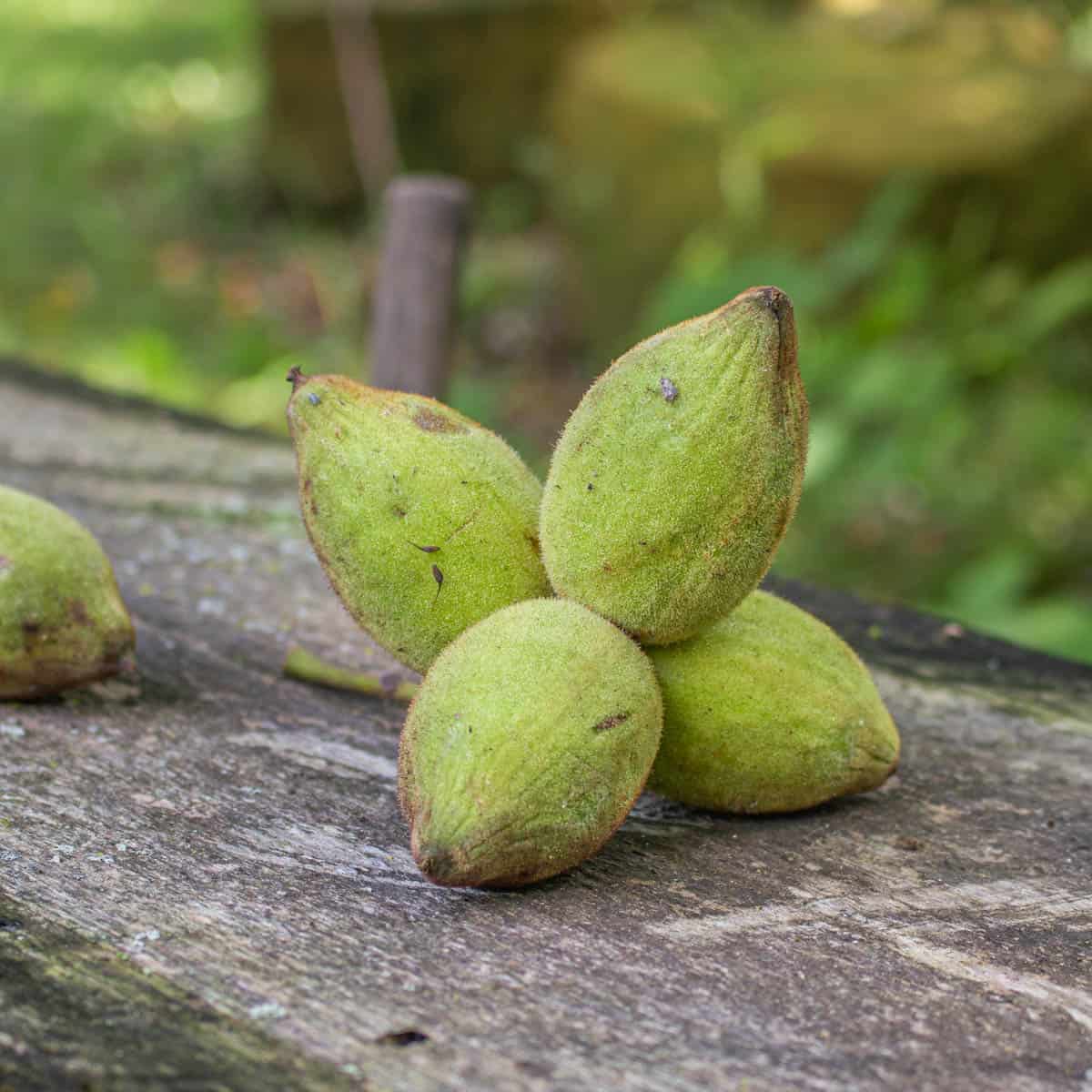
When I saw my first butternut I had the same thought plenty of people have probably had: “that’s a weird looking black walnut”. They’re not black walnuts though. They’re butternuts, and in Minnesota, it’s illegal to harvest them, or even possess them—more on that later.
Butternuts vs black walnuts
Both nuts share the same genus: Juglans cinerea and Juglans nigra, respectively, and, at first glance, they look similar, as both nuts come in a green husk that will stain your fingers. Their shape is different though, as butternuts are much more ovoid than circular, a bit like miniature footballs.
While black walnuts can be a little annoying as they're prone to stain things, butternuts don't seem to be as bad in that regard, but they make up for it by being covered in sticky hairs, that, once you notice are hard to forget.
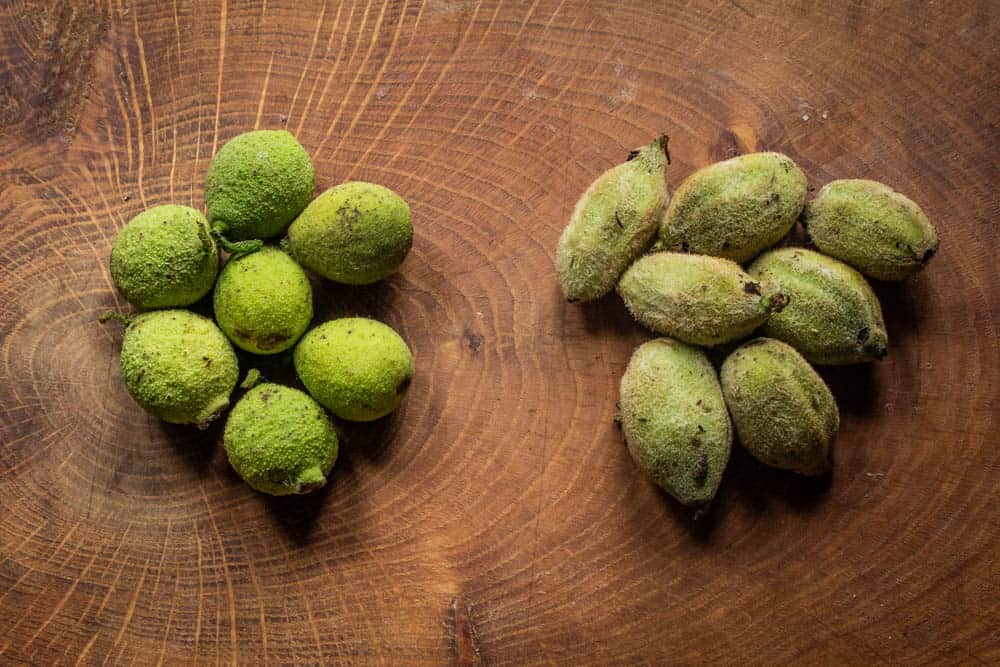
But, the biggest difference has to be in flavor. Butternuts have a smooth, mild buttery taste, and the ones I’ve tasted lack the stronger tannins I can get from skins of English walnuts from a store.
Freshly cracked ones, raw or lightly toasted, make for excellent eating. Black walnuts, on the other hand, have a strong, aromatic flavor I describe similar to menthol, musk, and earth—truly it's own taste.
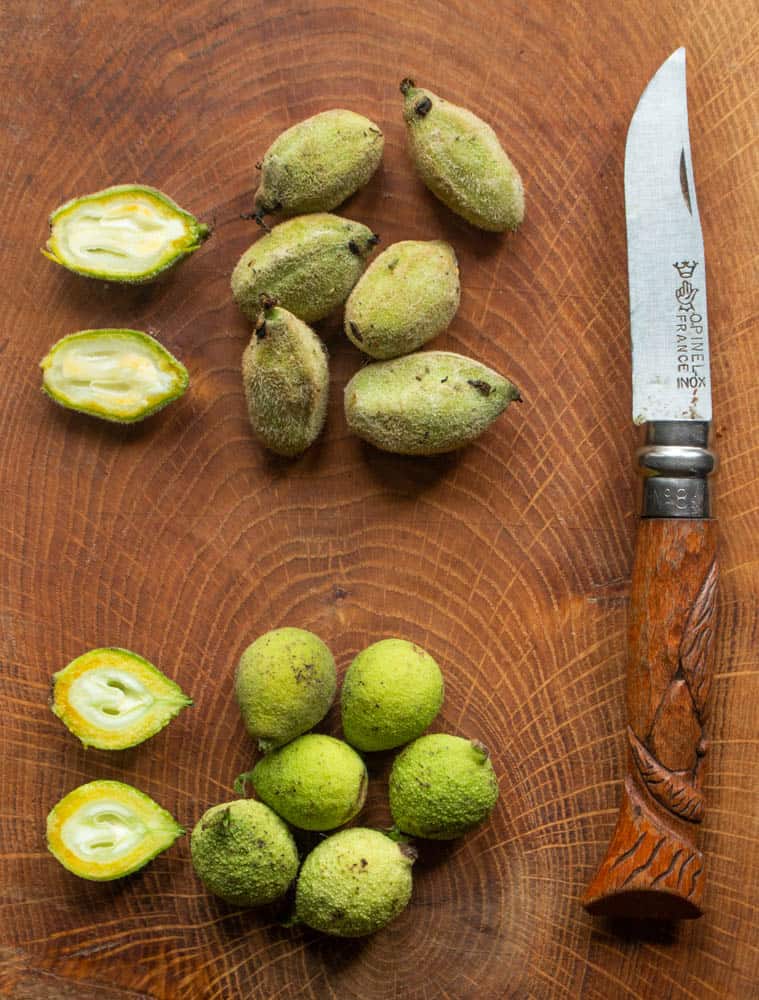
I love black walnuts, and could eat them by the handful, but the taste is so powerful many people strongly dislike them (the true sign of a delicacy!).
Butternuts have a mild, creamy taste anyone will love, and if you like regular walnuts, you'll like them, but first you'll have to find some.
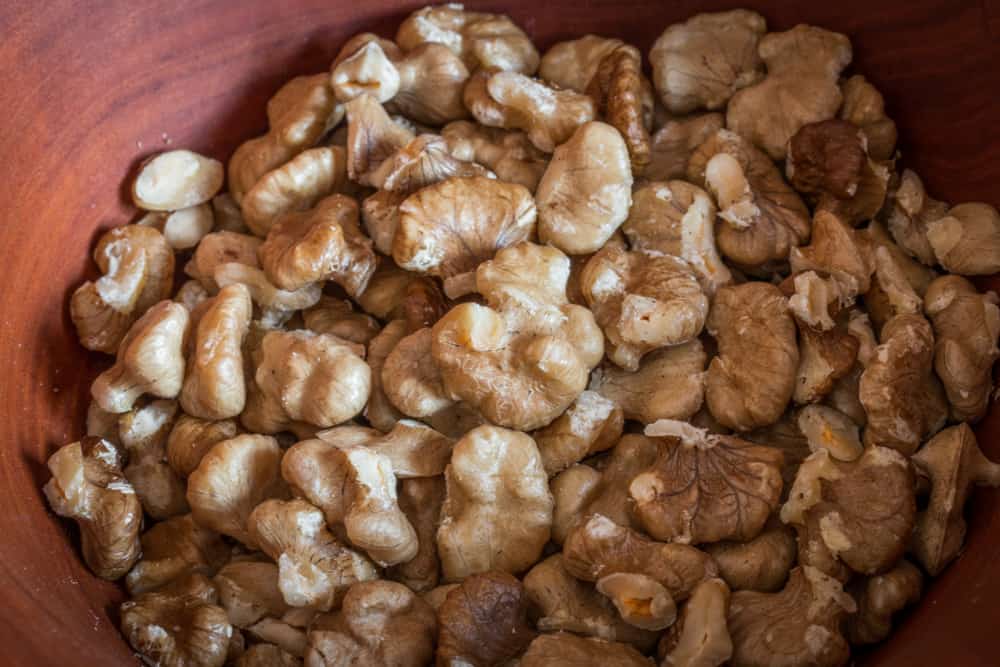
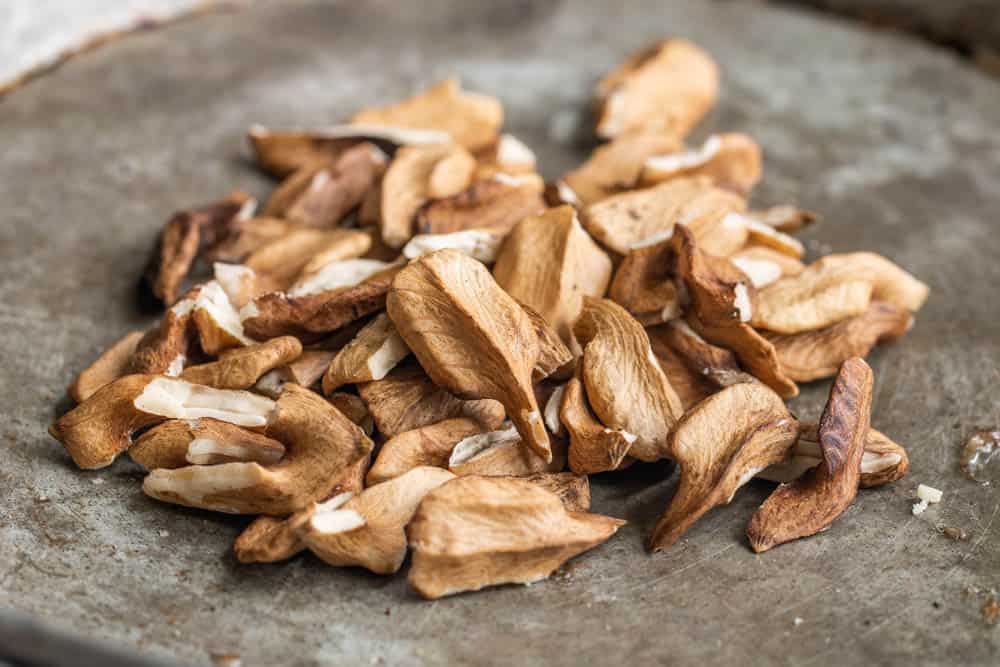
Early Drop
The tricky part is that butternuts drop early. Typically about a month earlier than black walnuts, falling around September where I live.
Most of you will be familiar with seeing black walnuts rolling around in the fall, but I’d never seen a single butternut on the ground, only on the tree itself, until Sam Thayer took me along time scout for some on the farm. We harvested butternuts, but not by collecting nuts already fallen like you might black walnuts.
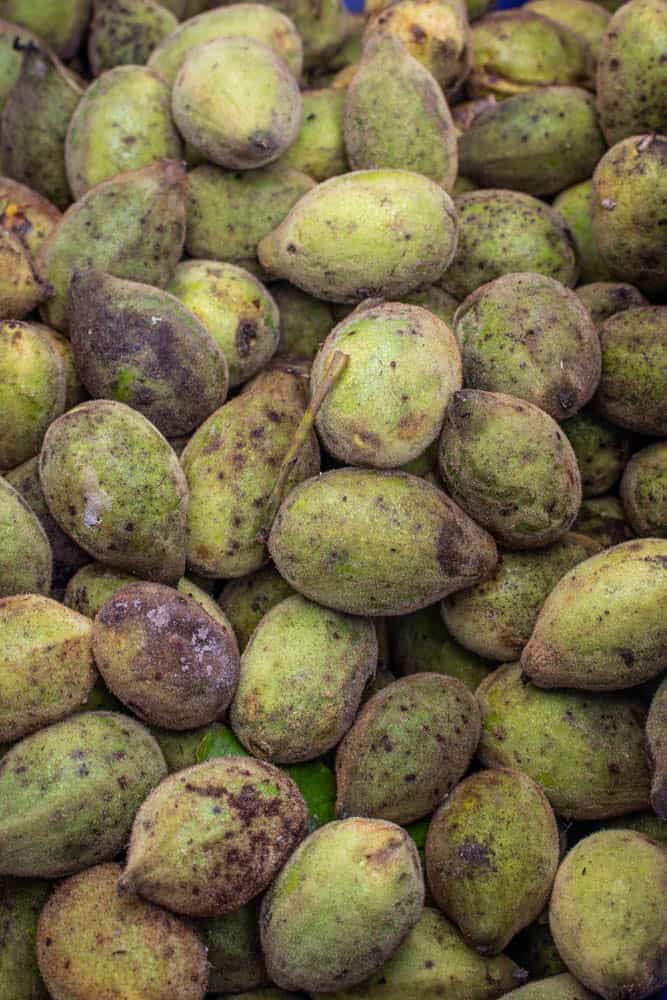
To get the butternuts, Sam climbed a tree to a height that made me nauseous, shook it with a sort of preternatural skill, and made it rain down an artillery of green mini-footballs.
I couldn’t believe how many gallons we picked up from just two trees! The simple act of shaking a choice tree, at the right moment, and making it rain down food, was a sort of command of nature I’d never imagined.
Just two modestly fruiting trees gave us 3 gunny sacks filled with enough butternuts to burden three grown men.
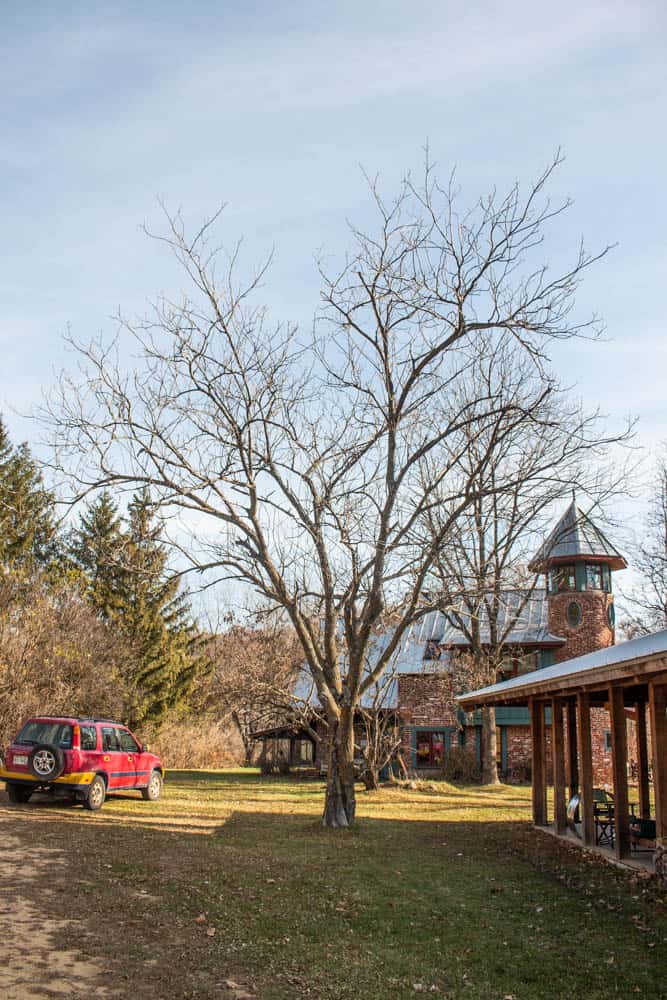
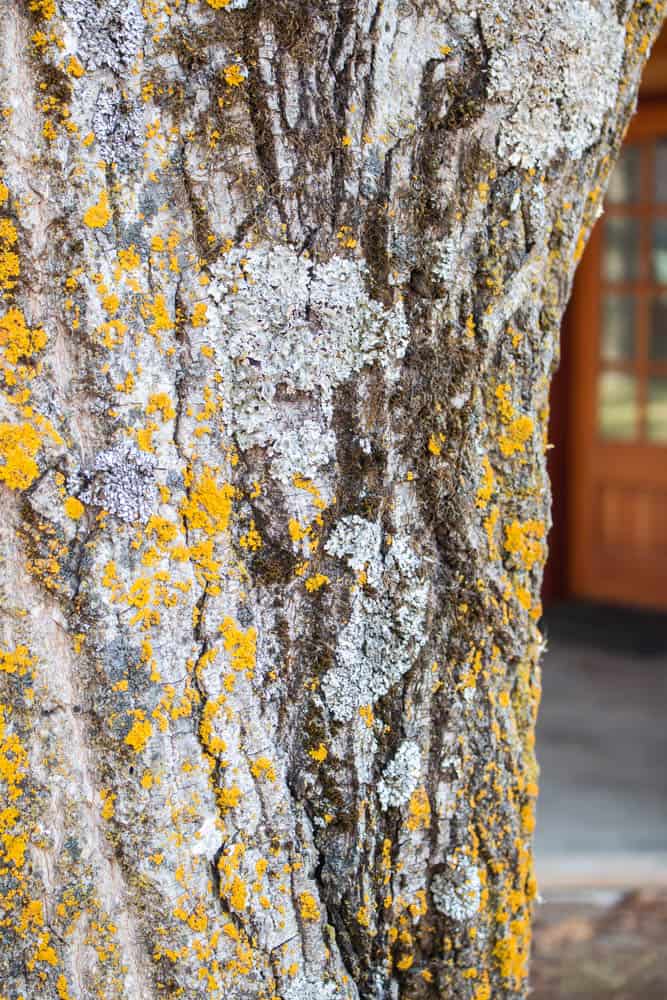
Tree Shape
One helpful trick Sam mentioned to me to make ID easier is a general rule I've never heard anyone else talk about.
For the most part, with exceptions, butternut trees are generally taller than they are wide, and black walnut trees are wider than they are tall. This can really help pick you pick them out from a distance.
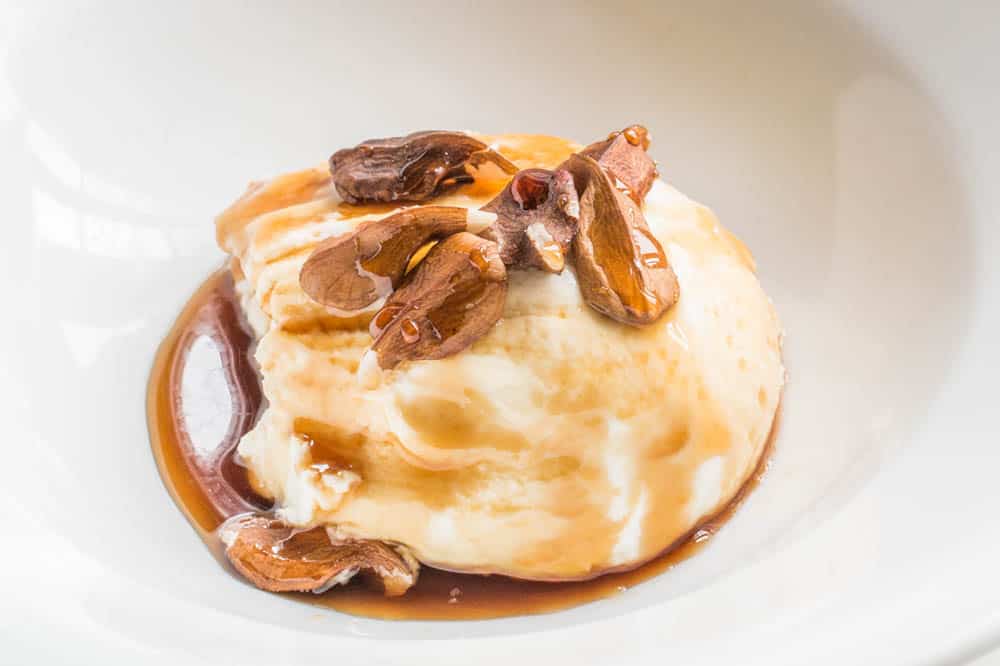
The Squirrels nut of choice
Just like black walnuts, butternuts do fall off the tree by themselves, but I’d never noticed a single butternut on the ground, and If you’ve never seen one either, don’t worry, you’re not blind. Jokes about squirrels and nuts abound, but I’m dead serious when I say squirrels seem to prefer butternuts above all other nuts that I’ve seen.
It’s a thing. With black walnuts, I see squirrels bopping around with them here and there, but they seem to pick them more leisurely.
Butternuts, by comparison seem to evaporate off the ground as soon as they fall without a trace—not a single one seems to be left unless I go to a certain tree in town I know of, the exposure to predators and other things probably making it more difficult for the professional nut harvesters. Butternuts exist though, and if you beat the squirrels, they can be yours.
Butternut canker and legality
Another reason you might not see butternuts is because of the disease that affects them. Butternut canker, a sort of fungus that attacks the trees, is bad news, similar to the blight that hit American chestnut trees as far as impact--not a good thing if you're a butternut tree.
Some trees I've picked from seemed to have a good resistance though, and if you look closely you can see the scars on the trunk to prove it.
Unfortunately, the losses in Minnesota are bad enough that the tree has been listed as "of special concern" since 1996, and is now considered endangered, and, in a nutshell, that’s why it’s illegal.
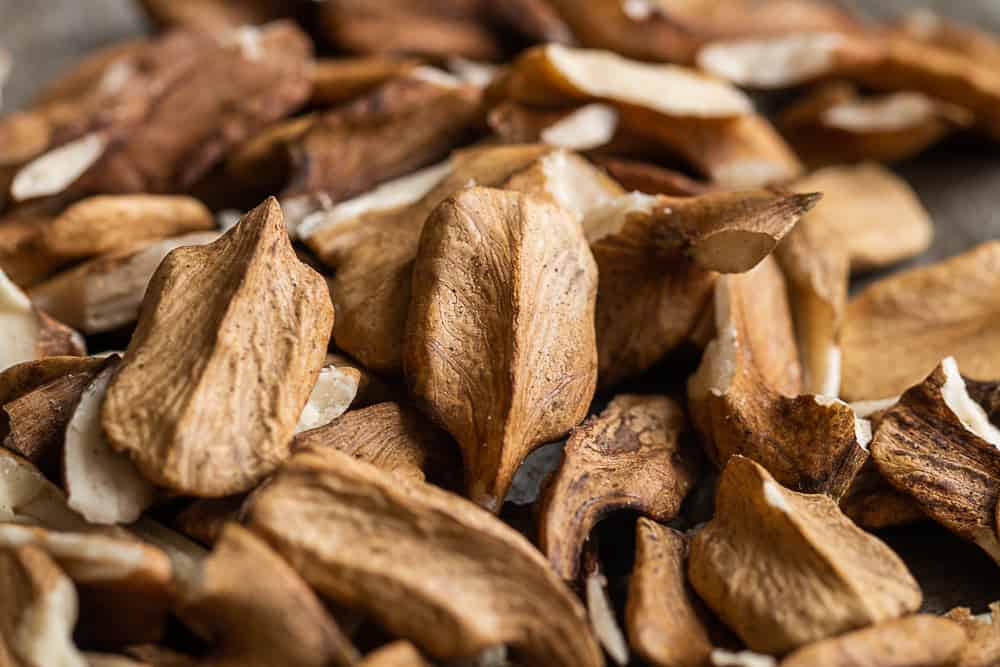
I couldn't believe that a food plant so reasonably well known in the wild food community could be illegal myself, so I called the Minnesota DNR and, after a number of calls over the span of a few months, I finally got the answer.
Essentially, listing it as an endangered species invokes the full legal the full legal protocol making it completely illegal to harvest or possess the nuts. Don't gather the nuts, pick them up, move them, eat them, plant them, or, drive around with some in your car, unless they're in a secret compartment.
That's right, even if you wanted to plant the trees, be the Johnny Appleseed of butternuts, you could technically be facing jailtime, a felony and all the trimmings that go with it, including the loss of your voting rights.
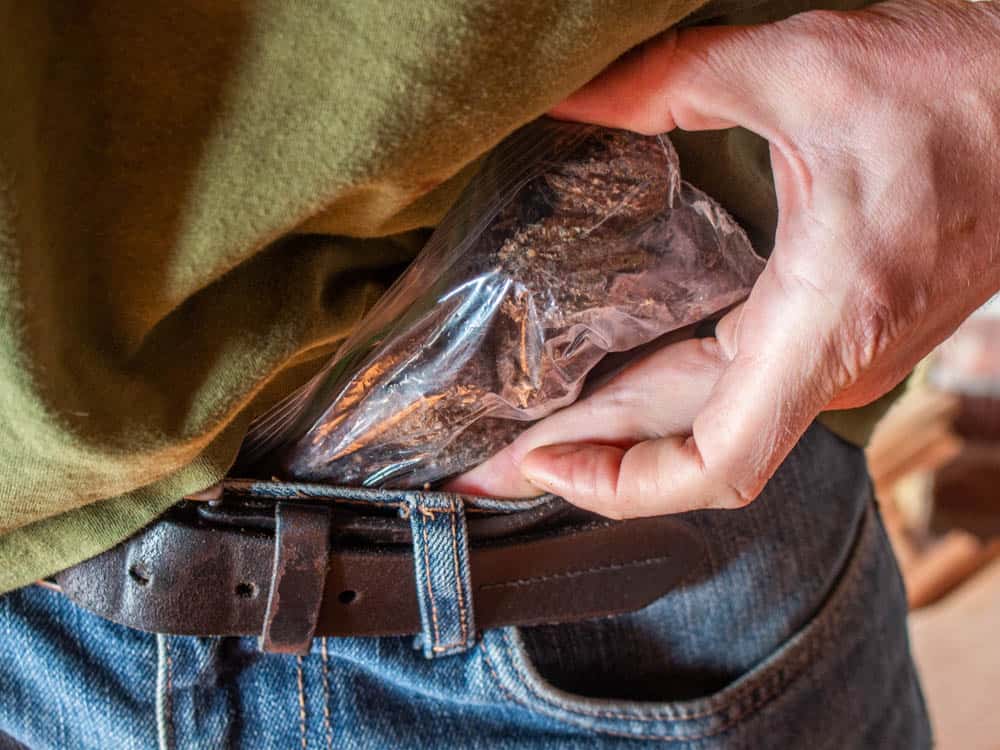
The law here is obviously overkill, but I can understand the intent. Plant gets blight disease that slowly destroys it? Put it on the endangered list--easy as, pecan pie, right? It seems to me like a knee jerk reaction that had unintended consequences.
At least to me, there's a difference to someone possessing the edible fruit of a tree that's harvested in quantity and legal in the surrounding states, to destroying the den of a timber rattlesnake, eating bald eagle egg omelets, or foraging other vascular plants that are endangered or threatened, like ginseng.
Not even the state can possess the nuts for propagation
It gets better though, and by better I mean bad. The law is fascinatingly byzantine in the case of butternuts, and I'm quoting the DNR here: "not even the State Nursery can possess the nuts for purposes of propagation".
So, you can't plant butternuts, I can't plant butternuts, and neither can the state. So, my question is, how the hell are we supposed to help this tree if no one can touch it? Is there nutting we can do?
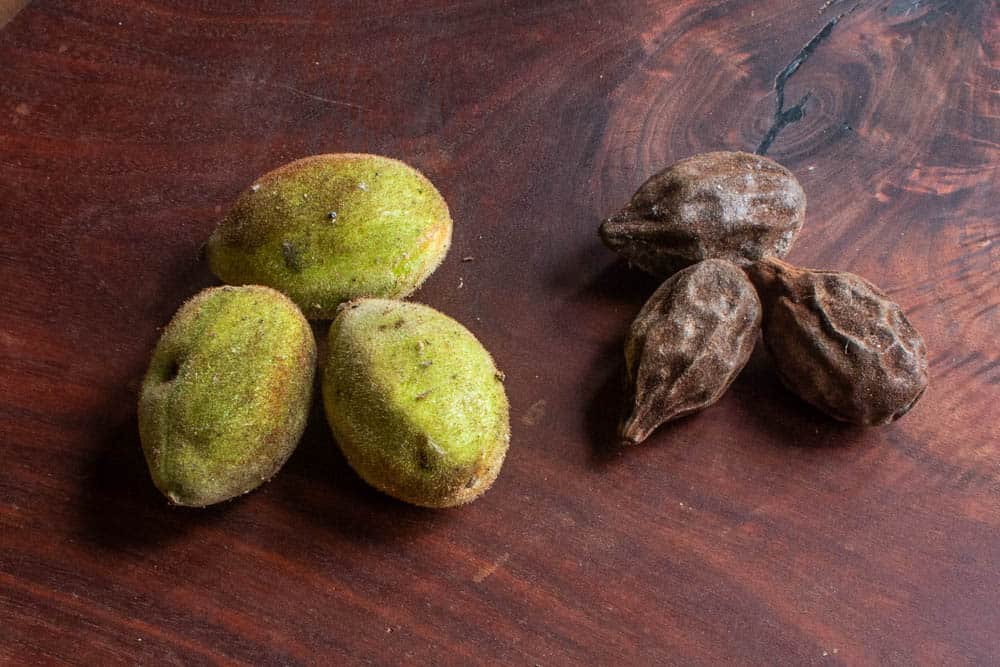
Harvesting and Storing
When you pick the nuts up off the ground, unlike black walnuts, butternuts won't be mushy and wormy--the hull will hold their shape.
With black walnuts, I like to roll each nut over with the heel of my shoe to remove the softened green hull as I pick, but with butternuts, I haven't found that necessary at all.
Harvesting
First, consider wearing gloves as you harvest to avoid staining your hands. Look for green nuts that appear to all dropped from the tree at the same time. Put the nuts into a container that can support weight, like a 10-gallon pail, bus tubs, or heavy Rubbermaid containers, then bring them home and set them out on large trays in a single layer, with a fan blowing on them to speed up the drying/curing process.
I keep commercial restaurant sheet trays around just for this purpose along with a speed rack that stores them vertically. Refer to the image below to see my setup (shagbark hickory nuts pictured).
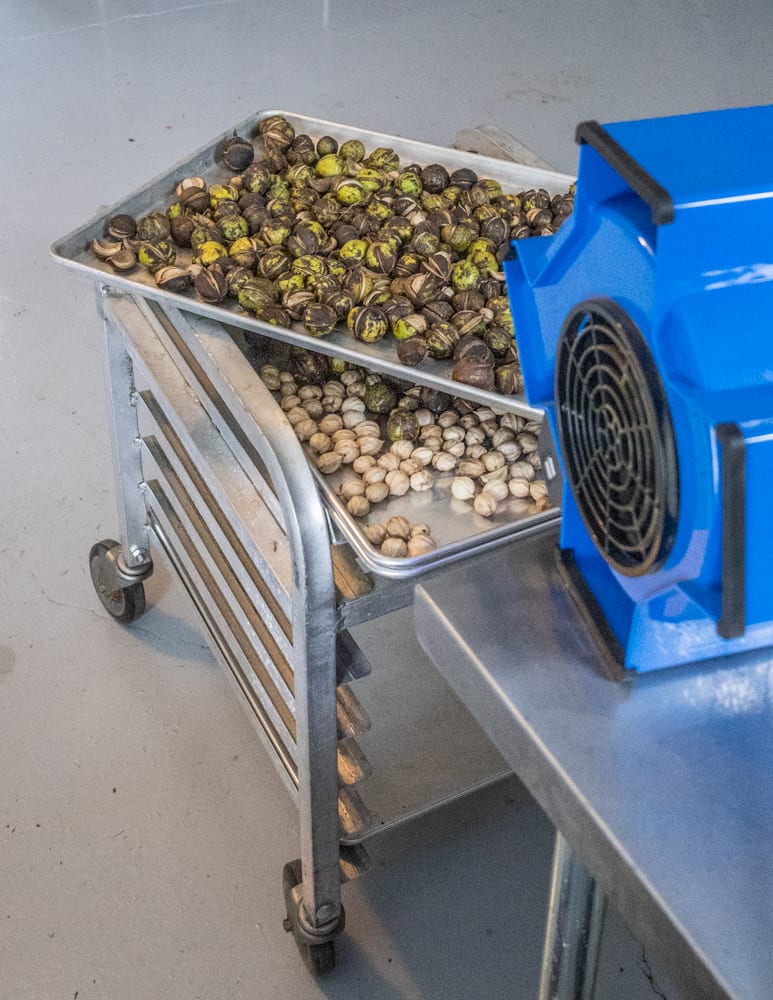
Butternuts, with their hulls attached, will take a little longer to dry than black walnuts or hickory nuts. Expect 3-4 weeks or more. If you feel like you want to remove the green hull, you can do that, and they'll dry faster and be ready to crack in as few as a couple weeks.
To remove the green hull, or not?
Some people like to remove the green hull before drying as nuts stored loose or piled in a container can change slightly in flavor as they age. I'm currently too lazy to do this, so I make sure that my nuts are stored in single layers, with a heavy duty fan blowing on them 24 hours a day until they're completely dry. I've found that as long as the nuts are dried as quickly as possible, the flavor of the butternuts seems just fine. I assume the change in flavor is due to slow decomposition of the hulls, but I'm speculating.
Storing
Finished, cured nuts can be stored at room temperature or in a cool dark place for a long time, similar to black walnuts. I've had dried butternuts last for multiple years in milkcrates in my garage.
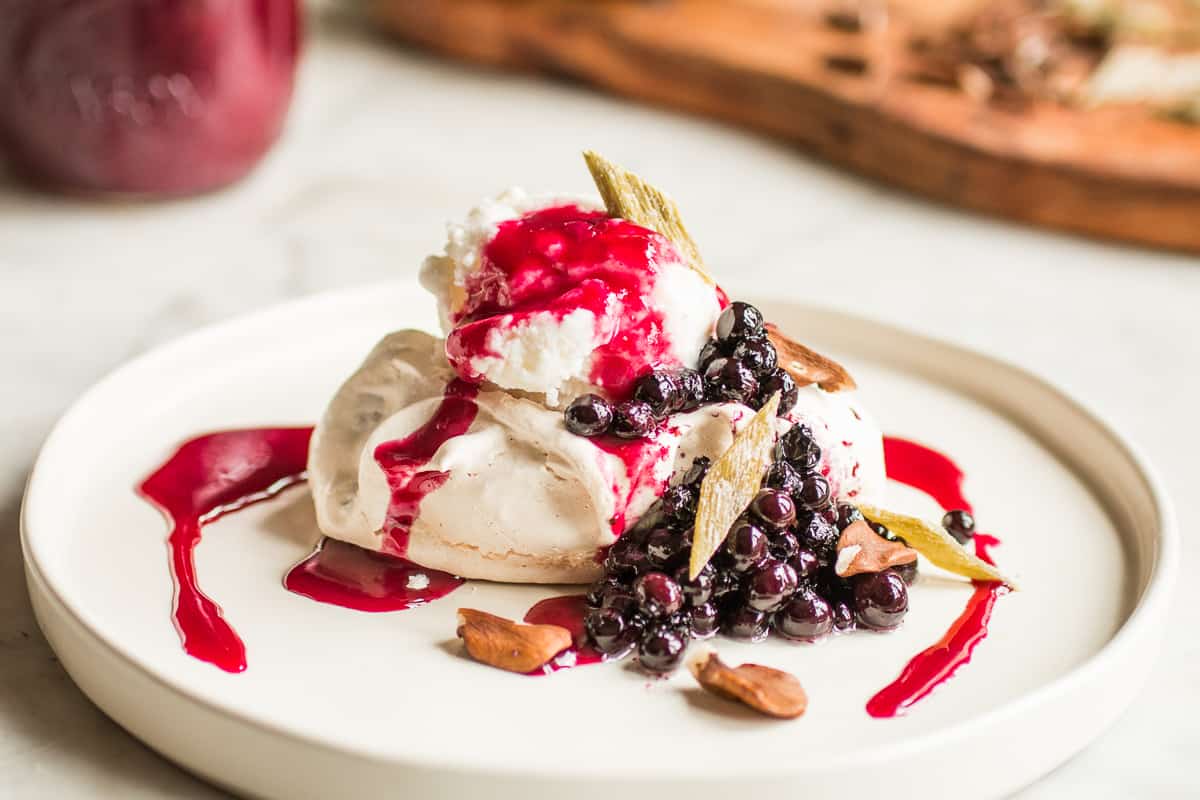
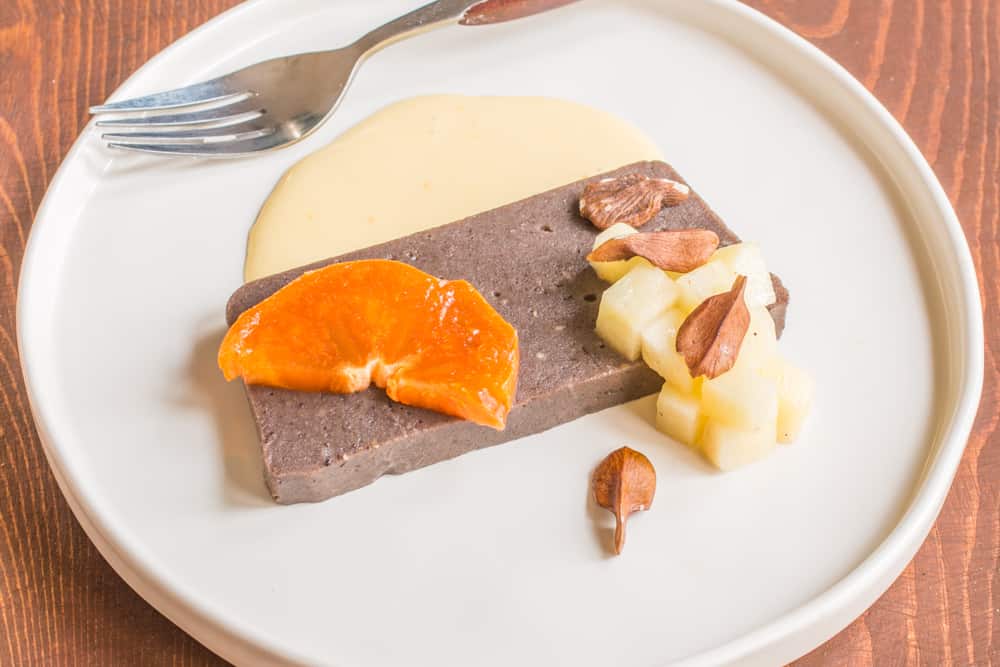
Cracking
Update: Grandpa's Goody Getter is now my go-to method for cracking, and it can crack dried butternuts with the hulls still attached. I highly recommend this as opposed to the hammer method, just like with black walnuts. Video demonstration at the end of this post.
This is the fun part, and for me, really challenging at first. After curing my first few attempts at cracking them were embarrassing, to say the least.
Just like other ancestral skills, cracking butternuts and black walnuts is a learned skill, and it takes practice to not smash the nuts to smithereens. I waited to share this until I could dependably get whole nut halves by myself, and I hope the quick video below can help illustrate the process.
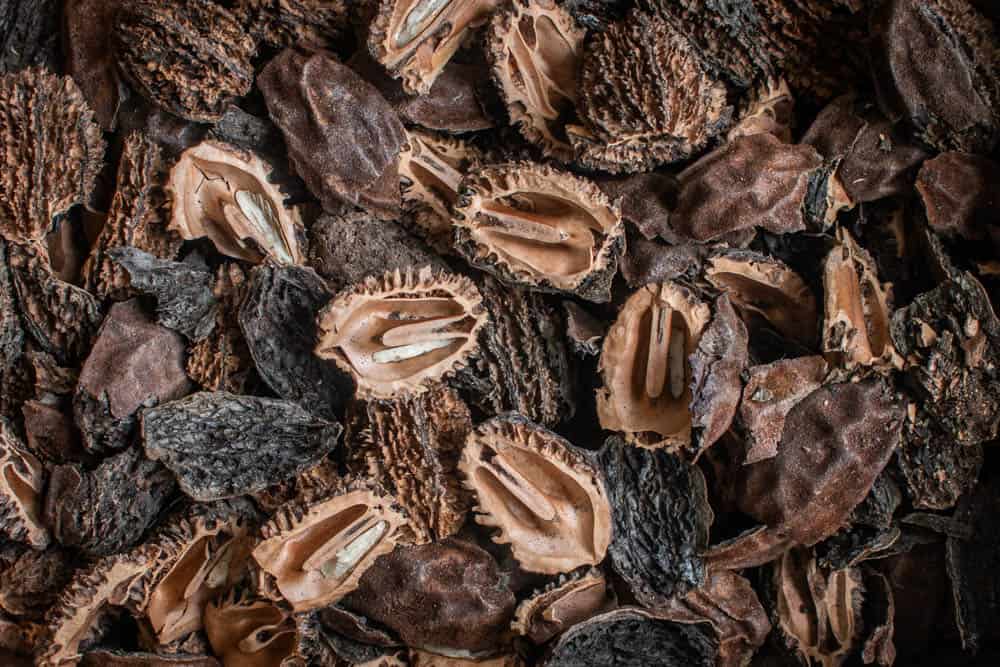
Basically, you have to first whack the nuts so they shed the dried black hull, after that, I hold them vertically preferably on a really firm surface, like a big stone and give them a whack, striking as "true" or as straight as possible, until I hear the audible "crack", just like black walnut.
Unlike black walnuts, butternuts only have two halves, so once I got the cracking part down, I've actually found them a bit easier to crack than black walnuts, which, in a perfect world, I can probably get 4 quarters from.
A tin snips can help spot treat the nut shells to help release the nut meats on difficult nuts, and is, yet again, another great trick passed down from Sam.
Related
Grandpa's Goody Getter: The Best Black Walnut Cracker
Guide to Shagbark Hickory Nuts
Further Reading/Listening
In Defense of Plants Butternut Podcast with Andrea Brennan, graduate research assistant focusing on butternuts and how hybrids could help save the tree from butternut canker.

Mike Nardella
We live in West Virginia and have an uncle who gave us a bushel of butter nuts. I’ve looked online for recipes pertaining specifically to butter nuts, but have had no luck. Any suggestions on something special? Or do we just use them as we would walnut? Butter nut butter? Thank you for your input.
Clarksburg, WV
Alan Bergo
Hey Mike thanks for commenting. Definitely try the ice cream first. It captures the flavor perfectly and people won't believe there aren't bananas in the ice cream.
Rebecca Gallagher
As a child I’d sit in the cement steps of our porch breaking butternuts with a hammer. That was over 50 years ago. The tree is still there in NJ.
Alan Bergo
Hey Rebecca thanks for commenting. Glad the tree is still standing!
Anna
Hi there, and very informative piece. Question: A relative of mine grows butternuts but I have yet to taste a good one and I am wondering why. We have picked them up promptly from the ground and husk them but each time, the nut tastes very strongly rancid. I know the butternut is an oily nut and have read they need to be husked soon. We have never shaken them from the tree. Do you think they just were on the ground too long, (as in, a week or few days)?
Alan Bergo
Hi Anna, this sounds strange to me. When I dry them, I pick and dry them promptly as soon as I know they're dropping, and I never remove the hull since I think it's a pain to remove. When dried quickly, I have had no reduction in quality and the nuts retain their subtle banana flavor. My suspicion here is that there's something with your drying or storing process that's off. Yesterday I ate a four year old butternut and it was perfectly fine, and it's been in my garage the whole time. But, if the nuts aren't thoroughly dried, they can definitely go rancid or get a moldy taste.
Laurie
Thanks for another helpful post. Our butternut tree finally has nuts on this year, so I went hunting for information on when to harvest.
We've gathered black walnut and Carpathian walnuts before, but not butternut. I'm looking forward to trying them.
Alan Bergo
Hey thanks Laurie. I just love them and I gathered some just last week.
Jarrod
We've had several trees and I still think they are a pain in the ass. We let them fall and get nice and sticky with all the dried leaves mixed together lol. Then we (the children) would gather them in five gallon buckets and transfer them to the gravel drive. Run them over with the car and the husks and all were nicely removed. Then we loaded them up and took them to the basement and poured them onto large wooden trays. As someone else mentioned, the ol' bench vice was the perfect cracker for hours of winter enjoyment. I think there might be a tray left in the basement and the last tree perished around 10 or so years ago. A couple years after the last tree was cut down, we ended up with a dozen or so yellow sponge Morels. So, that was nice. Enjoyed your story.
Julie
VERY interesting and informative. I just found your website. Thanks for all of the info!!
Alan Bergo
Hey thanks Julie.
Diane M Murphy
Do you know, can you cook over the butternut shells?
Alan Bergo
Hi Diane, I can't speak to that, but I don't see why not.
Diane M Murphy
When I was young my father would send me up the tree in September to shake the nuts down, whether it was the tree at home or the ones in the forest by my uncle's farm. Then the family would pick them up. We would lay three boards on the garage roof (or more depending on how many nuts we had, then put chicken wire on the board and the nuts underneath. A board at the top held the chicken wire down until we were done harvesting. I think the squirrels hated us. But the nuts would dry in the sun. When the outer shells were dry we'd pull them down and put them in lidded barrels. My parents would sit and crack paper bags full, then in the evening they would pick out the nuts while watching TV. Mom would freeze them in mason jars until she wanted some to cook with.
Alan Bergo
I love hearing the different traditions people have for using butternuts. They're such a good tree.
Bev Geibel
How long from the time you pick them off the ground and keep them in a box does it take for them to harden and get ready to crack open?
Alan Bergo
Bev, I adjusted that a bit for clarity. I recommend laying them on trays with a fan blowing on them until they're bone-dry. This will take at least a couple weeks. If you remove the green hulls they can be dried and ready to crack in as little as 2 weeks from my experience.
Bliss
I just wanted to let you know how absolutely, incredibly informative this article has been. I’ve been looking around online all day trying to understand more about the tree in my front yard here in our new home in Nova Scotia, and this is definitely the one! Thank you so much for helping me understand this beautiful tree 🙂
Alan Bergo
Glad it was helpful for you.
No
The Minnesota DNR is retarded. Those people are dumbasses.
Alan Bergo
The law needs to be changed.
Camille
Thank God I don't have to husk them first! YOu're video was informative and the blog post gives me the confidence to go ahead and put my gems in a box and forget about them. Love it. Can hardly wait to start whacking.
Alan Bergo
Yes, no need to husk them. My friend Sam Thayer does, and says it gives them a better flavor, but I'm to lazy. I do remove the hulls from black walnuts though.
Dwight
I have a butternut tree in my back yard and your post completely explains how to harvest them, thx. Also I will have to check out the mushrooms talk. I live in Ontario and love going to pick morels. Cheers
Alan Bergo
Thanks Dwight. I just had some wind blow down the butternuts from my favorite tree. 40 lbs in 20 minutes. Can't wait to get cracking in the winter.
Zanis
Butternuts have hybridized with Japanese walnuts, and the hybrids can be hard to tell apart from true butternuts. You may have been picking 'buartnuts' so the legal issues may be moot. IDing guide:
https://www.extension.purdue.edu/extmedia/FNR/FNR-420-W.pdf
Alan Bergo
GTK, thanks Zanis.
Peter A
Great post! I recently toured Quebec for a month searching for pleasing rural landscapes and food. I visited 'A Garden of Nuts ("Aux Jardins Des Noix") where they're growing butternuts, walnuts and more on a commercial scale. http://aujardindesnoix.com. Their butternuts were great--buttery, smooth and mild as you say. But their locally adapted black walnuts? Phenomenal--my taste highlight of the month! They age and dry them extra-long and the resulting nutmeats had hints of parmesan, olive, and tangy butter. Whoah--don't know if they ship to the US, but it'd be worth asking.
Alan Bergo
Now I just have to translate the page. I'd love to try some.
Dave
Alan- not seeing the video sir,
Alan Bergo
Thanks, somehow that link was wonky, it's fixed.
Nick
Try using a bench vise to crack nuts. Line up the nut crank the handle, and a perfect crack every time. No worries about nuts of different sizes or smacking your hand or fingers.
Betsy Lane
Great post! I’d only heard of butternut squash (of course) and now I’m wondering whether the squash tastes like butternuts. And yes—the DNR rules seem a bit nutty to me, too!
Dj
Love that you found something unique & shared how you got them out.
Sam Schaperow
Wow. That's quite a lot about them. Also, that's a not I've been reading about, but I've never found such a tree. I hope to try it someday. Sounds worth it.
Sam Schaperow
Law not "lot".
Nut not "not".
Alan Bergo
Yeah I’d been collecting info and practicing my curing, cracking and shelling for a few years here. Better to have one deep dive than a few smaller ones. Hey thanks for looping me in on Mushroom Talk too, that podcast with Alan Rockefeller was really interesting. Makes me want to take up an offer someone sent me to hunt mushrooms in the volcanos by Vera Cruz.
Finney
Is the name of the podcast “mushroom talk”? I was searching and couldn’t find it. Thanks!
Alan Bergo
No, look up "Welcome to mushroom hour", scroll down a bit and find the episode with Alan Rockefeller.